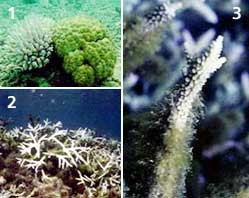Helping coral reefs survive climate change

1) Coral species can differ in their bleaching responses: the Acropora sp. on the left is bleached, while the Porites sp. on the right is not <br>Photo: Arjan Rajasuriya, Westmacott et al. 2000 <br> <br>2) Bleached branching corals (Acropora sp.) in the western Indian Ocean in 1998 <br>Photo: ARVAM, Westmacott et al. 2000 <br> <br>3) The tip of this coral colony (Acropora sp.) is bleached but alive, while the lower portion has died and is now overgrown with algae <br>Photo: ARVAM, Westmacott et al. 2000
While the high ocean surface temperatures during the 1997-98 El Nino bleached coral reefs in more than 50 tropical countries worldwide, patches of coral did survive in or near the damaged reefs. A new study of these patches identifies factors likely to protect these threatened marine ecosystems during climate change.
“As baseline sea surface temperatures continue to rise, climate change may represent the single greatest threat to coral reefs worldwide,” say Jordan West of the U.S. Environmental Protection Agency in Washington, DC, and Rodney Salm of The Nature Conservancy in Honolulu, Hawaii, in the August issue of Conservation Biology.
Coral reefs have among the greatest biodiversity of any ecosystem worldwide and provide key services to people, from food to coastal protection to tourism. Reef-building corals depend on symbiotic algae to photosynthesize much of their food, and surface waters that are warmer than normal can “bleach” corals by depleting their photosynthetic pigments or even make them expel their algae.
To help conserve coral reefs during climate change, West and Salm assessed factors that may have protected the coral patches that survived the 1997-98 bleaching. The factors fell into two categories: those that make corals resistant to climate change by, for instance, reducing local sea surface temperatures, and those that make reefs resilient to climate change by helping them recover from bleaching.
The researchers found that the factors that confer resistance to bleaching include local upwellings of cold water, and natural exposure to heat stress. For instance, in an area of Binh Thuan, Vietnam, upwelling of cold water brought surface temperatures down from 39 degrees C to 29 degrees C within days, and corals there recovered better than elsewhere in the country.
In addition, corals that emerge at low tides may be more tolerant of heat stress. For instance, in Palau’s Rock Islands, the reef flats that emerge during the low tide were bleached less than the parts of the reef that are in deeper waters.
The factors that confer resilience to bleaching include having diverse populations of corals that produce lots of larvae, surface currents that spread the larvae, herbivorous fish that graze the algae that otherwise grow on top of damaged reefs and prevent the establishment of new corals, and management that decreases stresses such as pollution and fishing methods that destroy reefs.
West and Salm recommend that coral reef managers use this work to identify and protect patches of coral reef that are most likely to persist during continuing climate change. Establishing reserves that protect networks of these patches will help ensure that the corals that survive a major bleaching event will be able to replenish those that do not. The Nature Conservancy is currently applying this work to help coral reefs recover from bleaching in the Republic of Palau, which is developing a national network of Marine Protected Areas.
Contact: Rodney Salm, (+1) 808-587-6284, rsalm@tnc.org
Media Contact
More Information:
http://conservationbiology.orgAll latest news from the category: Ecology, The Environment and Conservation
This complex theme deals primarily with interactions between organisms and the environmental factors that impact them, but to a greater extent between individual inanimate environmental factors.
innovations-report offers informative reports and articles on topics such as climate protection, landscape conservation, ecological systems, wildlife and nature parks and ecosystem efficiency and balance.
Newest articles

Innovative 3D printed scaffolds offer new hope for bone healing
Researchers at the Institute for Bioengineering of Catalonia have developed novel 3D printed PLA-CaP scaffolds that promote blood vessel formation, ensuring better healing and regeneration of bone tissue. Bone is…

The surprising role of gut infection in Alzheimer’s disease
ASU- and Banner Alzheimer’s Institute-led study implicates link between a common virus and the disease, which travels from the gut to the brain and may be a target for antiviral…

Molecular gardening: New enzymes discovered for protein modification pruning
How deubiquitinases USP53 and USP54 cleave long polyubiquitin chains and how the former is linked to liver disease in children. Deubiquitinases (DUBs) are enzymes used by cells to trim protein…



